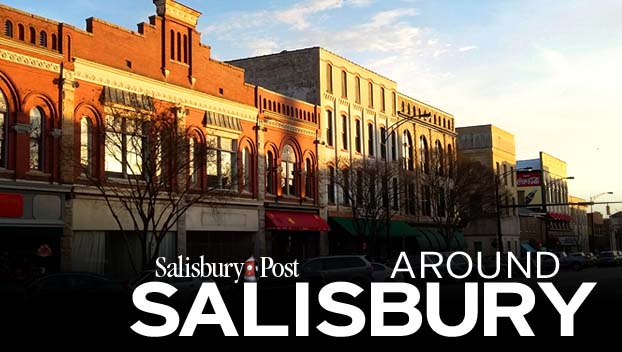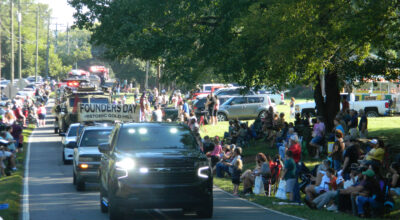Marker commemorating Jim Crow-era lynchings in Rowan County, racial injustice required years of work
Published 12:10 am Sunday, July 25, 2021
By Natalie Anderson
natalie.anderson@salisburypost.com
SALISBURY — For years, the local group Actions in Faith and Justice worked to find a site with sufficient historical context for a marker recognizing Jim Crow-era lynchings and acknowledging ongoing racial injustice.
Salisbury will witness the fruits of that labor on Aug. 6 and 7 when a marker from the Equal Justice Initiative is placed outside of Oak Grove-Freedman’s Cemetery, which contains more than 150 mostly unknown African-American men, women and children. In April, the city issued a certificate of appropriateness to install the marker, which shipped from EJI’s headquarters in Alabama. The marker made its way to Salisbury this week.
The marker will be in proximity to the Rowan County Courthouse, where three Black men named Jack Dillingham, John Gillespie and Nease Gillespie were abducted and dragged from the Rowan County Jail to what is now North Long Street and lynched by a white mob of more than 5,000 people. The three had been accused of the axe murders of four members of the Lyerlys, a white family who lived in the Unity Township at Barber Junction.
The marker will be 3.5 feet wide and about 3 feet high. On a black background with silver lettering, one side of the marker will commemorate local lynchings during the Jim Crow-era, not just the 1906 lynchings. The other side will provide broader historical context about the frequent occurrence of racial terror lynchings in the U.S. as Salisbury is only a “microcosm” of what happened across the nation. Called the Community Remembrance Project, EJI has placed such markers in cities in Alabama, South Carolina, Georgia, Mississippi, Texas, Missouri, Tennessee, Virginia, Maryland, Ohio, Oklahoma and Minnesota. Salisbury’s marker will be the first in North Carolina.
Efforts to install the marker in Salisbury date back to 2017, when a service of “Truth, Healing and Reconciliation” was held at North Long and Gillespie streets near the site of the 1906 lynchings. Since then, the AFJ has worked with Equal Justice Initiative to continue community engagement that centers the experience of past and present racial injustice experienced by Black Americans.
Through the Community Remembrance Project, EJI has documented 4,084 lynchings in 12 Southern states, including North Carolina, between the end of Reconstruction in 1877 and 1950, which is at least 800 more lynchings in these states than previously reported, according to EJI’s “Lynching in America” report.
Susan Lee, co-chair of AFJ and an organizer for the project, said contact was made with the EJI after the 2017 program to request advice on how best to support Salisbury’s citizens in processing the public act of remembrance.
“We were committed to supporting the community beyond a ‘one and done’ event that had deep emotional reverberations,” Lee said. “Our intention was to provide the community with opportunities for dialogue and forums for exchange of ideas, if needed.”
As it turned out, EJI would soon be on its way to meet with Charlotte residents, with two hours to squeeze in its schedule for Salisbury. Lee said she pulled together eight people with interest in continuing public acknowledgment of known lynchings in Rowan County. Among those who attended were Yolander White, Janine Rhodes, Alberta McLaughlin, Jeff Sharp, Isaac Heggins and Al Heggins, who became mayor later that year.
Following that event, AFJ formally applied for the historical marker program, Lee said.
“With that attendance a year following the 2017 event, we were assured there was continuing public interest in going forward,” she said.
Taking inspiration from its name, AFJ has progressed its work with help from local faith leaders. Among them are Rev. Derrick Anderson of Soldiers Memorial Church, AFJ co-chair Rev. Olen Bruner, who formerly pastored Trinity Presbyterian Church, Rev. Rhodes Woolly of St. John’s Lutheran Church and Rev. Robert Black of St. Luke’s Episcopal Church.
The 2017 event was a lesson and inspiration for some, including Betty Jo Hardy, another AFJ member. Hardy chaired the site installation subcommittee formed within the Public Art Committee to progress the project, with Barbara Perry, A. J. Alexander and Rev. Dr. Sharon Grant of Hood Theological Seminary serving as other members. Local philanthropist Ed Norvell is another Salisbury resident who helped propel the project during its infancy stages.
Hardy said the 2017 event resulted in “a reckoning within myself” because she was not aware of much that was depicted. One statement from the film she recalls spoke about how Black people do not have the privilege of forgetting past traumas.
“The extent of the terrorism, the traumatization of the Black community just to keep them suppressed … This horrendous act that took place just needed to be recognized,” Hardy said. “Salisbury is known for its history and historic preservation, but this is a history that has been hidden and not talked about it. But it needs to be acknowledged.”
The yearslong process for the marker can be attributed to challenges with securing a location appropriate and reverent enough for the marker. Perry told the Post she was asked to join the effort because of experience of installing plaques and signs through the Public Art Committee. She said the site selection process seemed simple in the beginning and became complicated because no sites seemed to work.
The subcommittee held public input sessions and had members meet at the sites to discuss them. Originally, the committee sought the lawn in front of the Rowan Museum for the marker because it was the courthouse at the time of the lynchings. Perry said that location was difficult because it was on a state-maintained road, which has its own set of regulations.
Then, there was a desire to place the marker inside of the Freedman’s Cemetery, but city staff expressed concern with land development ordinance guidelines for signs, particularly related to the height and pole type. Members also tried green space located across from the Rowan County Administration Building on West Innes Street, but Hardy said it was a challenge to get the county on board.
Churches were also considered, Perry said. Though they weren’t opposed, concerns arose that a sign outside a church would indicate to people that the lynchings occurred there.
Members also considered the intersection of 11th and North Main streets, which is thought to be two blocks away from the site of the lynchings, but concluded it wasn’t prominent enough. Ultimately, members selected a location between a sidewalk and curb of North Lee Street near Oak Grove-Freedman’s Cemetery because it is seen as a parallel to honor the work of people who are buried in the cemetery as well as those who turned the cemetery into a memorial.
Perry said the site is ideal because of its proximity to the museum, local churches and the site where it happened.
“I’m so thankful it’s all come together finally,” Hardy said. “It’s been a long journey and a lot of disappointment along the way. And we’ve been persistent.”
Perry commended the city for its support, noting that staff met subcommittee members at various sites to discuss the feasibility. In January 2019, City Council members passed a Resolution of Reconciliation condemning “all acts of violence and racial terrorism perpetrated against African-Americans, from which they were not rightfully protected during the Jim Crow era” and initiating the process of “reconciliation of racial injustice.”
“It was a hard but very rewarding process,” Perry said.
In addition to the historic marker, AFJ’s School Justice Partnership works to support equity in school discipline and to keep students in school and out of court. The kickoff event for that project took place in August 2018, and it was attended by more than 170 people.
Contact reporter Natalie Anderson at 704-797-4246.







